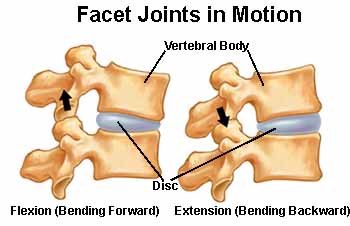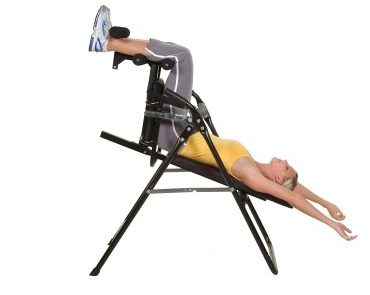This article contains affiliate links. If you make a purchase after clicking on a link I may earn a small commission at no extra cost to you.
Inversion Therapy and the Inversion Table Side Effects
The goal of Inversion therapy is to separate vertebrae to create more space for nerves where they exit the spinal column, or to relieve pressure on the vertebral discs or facet joints. History reveals various forms of traction been used for pain relief since as early as the time of Hippocrates.
Up to 30 per cent of physiotherapists in Ontario, Canada, use spinal traction for sub-acute low back pain and acute low pain with sciatica.
The rationale behind traction is that it causes spinal elongation through increase of intervertebral space and relaxation of spinal muscles.
However, spinal traction is unlikely to reduce or stabilise a prolapsed or herniated disc or make an annular tear disappear.
To date there is little evidence of how traction truly works. Many causes of low back pain can directly or indirectly attributed to the effect of compression on spinal structures.
Various types of traction are used in the treatment of low back usually in conjunction with other treatments. The most common forms of traction for the treatment of low back pain are mechanical or motorised traction (where the traction is exerted by a motorised pulley) and manual traction (in which the traction is exerted by the therapist, using his or her body weight to impart the force and direction of the pull).
Some traction units require the patient to lie face down while treatment is n; other units place the patient on their backs.
Traction can be applied intermittently or continuously. Intermittent action is where the force of pull is used on and off.
Continuous traction is when the force of pull is held for an extended period of time, usually no more than 30 minutes.
For the lumbar spine the amount of traction needed to begin genuine separation of the vertebrae is half the patient’s body weight. Inversion tables are a form of traction that uses a person’s own body weight and gravity to stretch the spine.
Inversion tables can be purchased by anyone and used at home; however, approval from a practitioner should be sought first. Some forms of spinal manipulation apply traction very specifically, but this would be recognized as manipulative therapy rather than traction.
Manual traction of the lumbar spine only increases the height of each disc by approximately 0.1 mm, but this net gain is lost as soon at the patient stands up and gravity loads the spine.
Benefits Of Inversion Therapy
Traction therapy can help acute and chronic non-specific mechanical low back pain, spinal nerve root impingement, herniated lumbar disc, ligament encroachment, narrowing of the intervertebral foramen, osteophyte encroachment, spinal nerve root swelling, joint hypomobility, degenerative joint disease, extrinsic muscle spasm and muscle guarding, discogenic pain, joint pain and compression fracture (sub-acute stage).
Reasons this treatment might not be suitable for you
Traction therapy should be avoided if there is acute inflammation, strains, sprains, joint hypermobility, pregnancy, cauda equina syndrome, aortic aneurysms, hiatal hernia, active peptic ulcer, osteoporosis, inflammatory arthritis and spondylolisthesis.
Some patients with respiratory problems or those with claustrophobia may be unsuited to this treatment if a restrictive harness is used.
Treatment effects of Inversion Therapy
Proposed physiological effects include distraction or separation of the vertebral bodies, a combination of distraction and gliding of the facet joints, tensing of the ligamentous structures of the spinal segment, widening of the intervertebral foramen, straightening of spinal curves and stretching of the spinal muscles.
Patients will experience some form of pain relief by decreasing the compressive forces being placed on the spine.
Positive attributes
Many variations of traction exist and there are many different protocols. Traction is widely available and relatively inexpensive.
Negative attributes
It is difficult to identify patients who may benefit from traction. Continuous traction has proven to be relatively ineffective and to often aggravate patients’ symptoms. The patient must be relaxed during treatment for in vertebral separation to occur. To facilitate patient relaxation, the treatment must not aggravate the condition, and the patient must feel secure I well supported.
Excessive force can increase pain or cause injury. Many traction protocols require multiple sessions over several weeks.
Potential Inversion Table Side Effects
Side effects include increased pain, respiratory constraints while wearing traction harness or increased blood pressure during inverted positional traction. Anxiety is a common side effect with inversion traction. Rare complications include nerve impingement with heavy traction.
Recommendations
A trial of traction and compression tests should be used to determine if I are a suitable candidate for traction before undergoing treatment. If manual tests cause no pain or provide relief, you are probably suitable traction therapy. Large traction forces (more than half of your body fight) should be avoided.
Proof of effectiveness
Results of a systematic review found that traction as a single treatment for back pain was more effective than placebo, sham or other treatment. For patients with sciatica there is moderate evidence that continuous or intermittent traction is no more effective than other treatments.
Another review concluded that traction is most likely to benefit patients with acute nerve root pain with concomitant neurological deficit. Spinal traction is rarely given in isolation and is often provided in combination with other treatment modalities.
The main finding in the literature is that there is a lack of high-quality studies on spinal traction, which makes it difficult to form any concrete illusions regarding effectiveness of traction.











No comments yet.